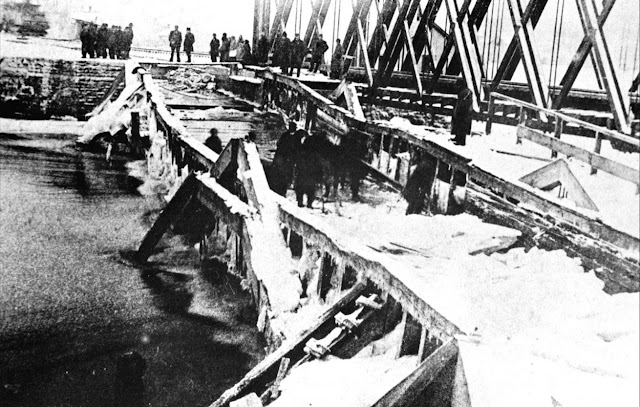 |
| 20171217,18 9060 |
 |
| Right insert in above sign |
 |
| Left insert in above sign |
On March 7, 1867, the Tennessee River began to rise at the rate of one foot per hour. Chattanooga experienced floods every spring, but this one, later known as the Great Flood, continued to rise until March 11, when the waters crested at 57.9 feet above low water levels. The second day of the flood sent the Meigs Military Bridge (minus the stones from the Bluff Furnace walls) floating downriver, and by the fourth day, all but the highest ground in the city was under several feet of water. The inset photograph on the right, taken from Lookout Mountain, shows Chattanooga under this, the greatest flood in East Tennessee's recorded history. The bottom left of the photograph shows the part of Moccasin Bend which stood above the water. Above that (to the North) is the top of Cameron Hill, and to the east of this is the high ground which bounded, roughly, by the bluff and today's McCallie Avenue.
This flood (and two others in 1875 and 1886, both of which were more than 50 feet above low water levels) convinced the city, when rebuilding, to significantly raise the levels of Chattanooga's streets. In some cases, current street levels are as much as ten feet higher than those of the last century. But even with today's street levels, a flood on the scale of the Great Flood would reach the second level of many buildings on Market Street.
After the loss of the Meigs Bridge, ferries were again the only means of crossing the river. This remained the case for more than twenty years, until the Walnut Street Bridge was constructed. After a considerable delay because of contracting difficulties, construction finally began in July, 1889. The contractors built a wooden cofferdam that stood above water when it was placed on the riverbid. When the water was pumped out of the cofferdam, excavators removed sand and gravel to reach bedrock. When this was accomplished, masons constructed the piers on the dry riverbed. In one location, the contractor's pumps were not strong enough to draw all the water from the cofferdam, and the city had to loan their fire engine to the construction effort. For two days the engine pumped out water while floating on a barge that, were it necessary, could take it back to shore to fight a fire.
In June, 1890, four of the six piers were finished, and work on the superstructure began. Nine months later, the Wlanut Street Bridge was officially opened. A large crowd attended the celebration, and the city was proud of this new link to the north bank of the river. Local boats, like the J.C. Warner (inset photograph at far left), could easily navigate the 320 foot spans, and water levels were never likely to get high enough to prevent boats from passing.
The Walnut Street Bridge established the first permanent link between Chattanooga and the rest of Hamilton County, and for the first time in seventy-five years, ferries stopped crossing the Tennessee to land to Ross's Landing.



















































